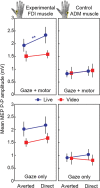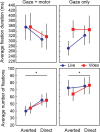Eye contact enhances interpersonal motor resonance: comparing video stimuli to a live two-person action context
- PMID: 31506688
- PMCID: PMC6917019
- DOI: 10.1093/scan/nsz064
Eye contact enhances interpersonal motor resonance: comparing video stimuli to a live two-person action context
Abstract
Previous research has shown a link between eye contact and interpersonal motor resonance, indicating that the mirroring of observed movements is enhanced when accompanied with mutual eye contact between actor and observer. Here, we further explored the role of eye contact within a naturalistic two-person action context. Twenty-two participants observed simple hand movements combined with direct or averted gaze presented via a live model in a two-person setting or via video recordings, while transcranial magnetic stimulation was applied over the primary motor cortex (M1) to measure changes in M1 excitability. Skin conductance responses and gaze behavior were also measured to investigate the role of arousal and visual attention herein. Eye contact significantly enhanced excitability of the observer's M1 during movement observation within a two-person setting. Notably, participants with higher social responsiveness (Social Communication subscale of the Social Responsiveness Scale) displayed a more pronounced modulation of M1 excitability by eye gaze. Gaze-related modulations in M1 excitability were, however, not associated with differences in visual attention or autonomic arousal. In summary, the current study highlights the effectiveness and feasibility of adopting paradigms with high ecological validity for studying the modulation of mirror system processes by subtle social cues, such as eye gaze.
Keywords: action observation; eye contact; mirror neuron system; skin conductance; transcranial magnetic stimulation (TMS).
© The Author(s) 2019. Published by Oxford University Press.
Figures




Similar articles
-
Direct eye contact enhances mirroring of others' movements: A transcranial magnetic stimulation study.Neuropsychologia. 2017 Jan 27;95:111-118. doi: 10.1016/j.neuropsychologia.2016.12.011. Epub 2016 Dec 8. Neuropsychologia. 2017. PMID: 27939365
-
In the eye of the beholder: Social traits predict motor simulation during naturalistic action perception.Neuropsychologia. 2024 Jul 4;199:108889. doi: 10.1016/j.neuropsychologia.2024.108889. Epub 2024 Apr 24. Neuropsychologia. 2024. PMID: 38670526
-
To mirror or not to mirror upon mutual gaze, oxytocin can pave the way: A cross-over randomized placebo-controlled trial.Psychoneuroendocrinology. 2018 Apr;90:148-156. doi: 10.1016/j.psyneuen.2018.02.016. Epub 2018 Feb 22. Psychoneuroendocrinology. 2018. PMID: 29494953 Clinical Trial.
-
From gaze cueing to dual eye-tracking: novel approaches to investigate the neural correlates of gaze in social interaction.Neurosci Biobehav Rev. 2013 Dec;37(10 Pt 2):2516-28. doi: 10.1016/j.neubiorev.2013.07.017. Epub 2013 Aug 5. Neurosci Biobehav Rev. 2013. PMID: 23928088 Review.
-
Visual attention and action: How cueing, direct mapping, and social interactions drive orienting.Psychon Bull Rev. 2018 Oct;25(5):1585-1605. doi: 10.3758/s13423-017-1354-0. Psychon Bull Rev. 2018. PMID: 28808932 Review.
Cited by
-
Conditional effects of gaze on automatic imitation: the role of autistic traits.Sci Rep. 2020 Sep 23;10(1):15512. doi: 10.1038/s41598-020-72513-6. Sci Rep. 2020. PMID: 32968117 Free PMC article.
-
Autonomic and facial electromyographic responses to watching eyes.Iperception. 2024 Jan 22;15(1):20416695231226059. doi: 10.1177/20416695231226059. eCollection 2024 Jan-Feb. Iperception. 2024. PMID: 38268784 Free PMC article.
-
Enhanced mirroring upon mutual gaze: multimodal evidence from TMS-assessed corticospinal excitability and the EEG mu rhythm.Sci Rep. 2020 Nov 24;10(1):20449. doi: 10.1038/s41598-020-77508-x. Sci Rep. 2020. PMID: 33235329 Free PMC article.
-
The Changeable Positioning of the Couch and Repositioning to Face-to-Face Arrangement in Psychoanalysis to Facilitate the Experience of Being Seen.Front Psychol. 2021 Nov 12;12:718319. doi: 10.3389/fpsyg.2021.718319. eCollection 2021. Front Psychol. 2021. PMID: 34867597 Free PMC article. No abstract available.
-
Adults Do Not Distinguish Action Intentions Based on Movement Kinematics Presented in Naturalistic Settings.Brain Sci. 2021 Jun 21;11(6):821. doi: 10.3390/brainsci11060821. Brain Sci. 2021. PMID: 34205675 Free PMC article.
References
-
- Alaerts K., Swinnen S.P., Wenderoth N. (2009a). Is the human primary motor cortex activated by muscular or direction-dependent features of observed movements? Cortex, 45(10), 1148–55. - PubMed
-
- Alaerts K., Van Aggelpoel T., Swinnen S.P., Wenderoth N. (2009b). Observing shadow motions: resonant activity within the observer’s motor system. Neuroscience Letters, 461(3), 240–4. - PubMed
Publication types
MeSH terms
LinkOut - more resources
Full Text Sources
Medical

